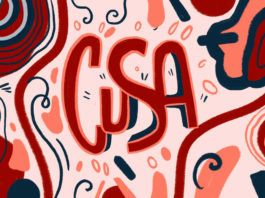Indian activist—Mahatma Gandhi—has been celebrated around the world for his philosophies of civil disobedience and nonviolence, including a statue in his honour in front of Richcraft Hall at Carleton. But recently, the Carleton community have began to question honouring what they feel is a tainted legacy.
This criticism of the social justice icon’s legacy came to light in May, when members of the South Asian community were invited to speak at a forum hosted by the Canada-India Centre for Excellence (CICE) on campus.
The event, which was meant to be a discussion of issues facing Indian affairs in Canada, quickly turned away from its main topic when Pieter Friedrich, a South Asian affairs analyst, referenced the Gandhi statue outside Richcraft Hall—the building that houses the CICE.
Friedrich spoke of Gandhi’s dark past, making particular reference to his defence of the caste system—an ancient Hindu practice that claims certain members of society as higher beings based on their supposedly inherent purity. He also spoke about Gandhi’s experience with racial segregation in South Africa, and concluded that for these reasons, the statue is “a symbol of racism, of oppression, and it needs to toppled.”
At the event, Ontario-based Sikh leader, Manisha Bangar, said that instead of Gandhi, Carleton should have chosen to honour another Indian leader such as prolific Indian activist, Bhimrao Ambedkar. She said that Ambedkar’s philosophies against social discrimination were rooted in shutting down the caste system, for which he must be honoured.
But for Carleton, this was not the first instance of debate over whether the Gandhi statue should be replaced.
The tall bronze statue was unveiled at Carleton in 2011, on Gandhi’s birthday—a statutory holiday in India—by several foreign affairs leaders, including the High Commissioner of India.
Although a debate to remove the statue had started when it was first unveiled, it gained momentum once again last year, when a Carleton student wrote a letter published in the Charlatan. In his letter, Kenneth Aliu, the president of the Institute of African Studies Student Association (IASSA), protested against the statue and called Gandhi a racist and a pedophile.
“[Gandhi] utilised anti-Black racism as a weapon to bargain with the British about the subjugation of Indians living in South Africa,” Aliu wrote in his letter. “Instead of a pacifist liberator, he actually furthered the entrenchment of the caste system in India as well.”
The Gandhi statue is a result of the long-standing Western ignorance of Gandhi’s racism in India and South Africa, Aliu added.
“The removal of the statue is one way of correcting that history and re-thinking the narratives we tell,” he wrote.
Aliu’s letter quickly became the subject of much reaction from various student groups on campus, with several students taking to social media.
Katherine Nygard, a third-year global and international studies student, said the statue is more than just a commemoration.
“When we decide that someone as problematic as Gandhi can be given the honour of having a statue at a university, we also decide that we are accepting all those flaws,” Nygard said. “It is especially sad to see that the university has chosen him, out of all people, to be the face of Carleton’s relationship with India.”
Nygard added that the placement of the Gandhi statue—in front of Richcraft Hall—is what is causing the debate on campus.
“Carleton has had [a] very long relationship with India, which is shown through the [CICE] at Richcraft,” she said. “I think it’s horrible that the university chooses to honour this relationship with a figure like Gandhi, especially after the backlash the administration received after renaming the River Building as Richcraft [Hall].”
But, according to an official statement at the statue unveiling from 2011, former Carleton president Roseann Runte said “the location of the statue, in front of a building dedicated to international programs and home of the Canada-India Centre [is] appropriate in light of Gandhi’s message that we must be open to the ideas of the world.”
Aliu’s letter was shortly followed by another letter published in the Charlatan by Sheldon Paul, the vice-president (communications) of the Malayalee Student Association at Carleton, in which he supported Aliu’s stance.
In his letter, Paul said that at a time where South Asians are more divided than ever, an Indian activist’s statue is especially important for the community. He added that the Gandhi statue should be replaced with a better figure, echoing what Bangar would come to say months after.
However, unlike Bangar, Paul said that the statue should be replaced with one of Bhagat Singh, an Indian nationalist who was martyred for the cause of India’s independence from the British.
“Perhaps we should rethink complete deference to the respectability of age, and adopt a new, young role model of the same tenacity and fervor that we enter academia hoping to embrace and inspire,” Paul wrote in his letter.
Nadia Abdel, a second-year health science student, said she agreed with Paul.
“Whether it is a figure like Bhagat, or Ambedkar, they’re both much better than the controversial Gandhi,” Abdel said. “There’s so many other alternatives the university can look at that would be much more feasible [to represent] the views of the South Asian students on campus.”
In a recent interview with the Charlatan, Aliu responded to calls to replace the Gandhi statue.
“My editorial was [written] to raise awareness to remove the statue. In terms of what to replace it with, I think that is a decision that is up to the South Asian community on campus. It has nothing to do with me,” he said. “I think that when a statue is placed in a public space, we should revise who we are idolizing more carefully to respect victims of marginalization.”
But Aydin Karasapan, a second-year political science student, said he disagreed with replacing the statue.
In a letter published in the Charlatan, Karasapan responded to Aliu and Paul by defending Gandhi. He said that there was no proof to Aliu’s claims that Gandhi was a racist and a pedophile.
“When the British sought to segregate the lowest caste, the untouchables, from the rest of India, Gandhi began a fast until death,” he wrote. “Moreover, he had many of the most capable women in India in his entourage and at the vanguard of his movements, advising women to live safely in a society where they were often correctively raped with no justice, merely for keeping their hair ‘immodestly’.”
Earlier this year, the Carleton University Debate Society, IASSA, and the Ontario Public Interest Research Group (OPIRG) planned to host a forum to discuss the removal of the statue. The event—slated to take place in January—was cancelled abruptly due to unforeseen circumstances.
In an email, a spokesperson for OPIRG stated that the event was cancelled due to space issues and speakers pulling out.
Aliu, who was one of the panelists set to speak at the event, said that overwhelming student interest for the event was what caused the space issues.
“We got a big crowd in favour of the event—like 14,000 people online—but then due to capacity and time issues, we could not find a place in the required time that was suitable for the event,” he said.
Aliu said he plans on writing more letters and working more towards the removal of the Gandhi statue in the fall.
— With files from Mo Fahim
Graphic by Manoj Thayalan




